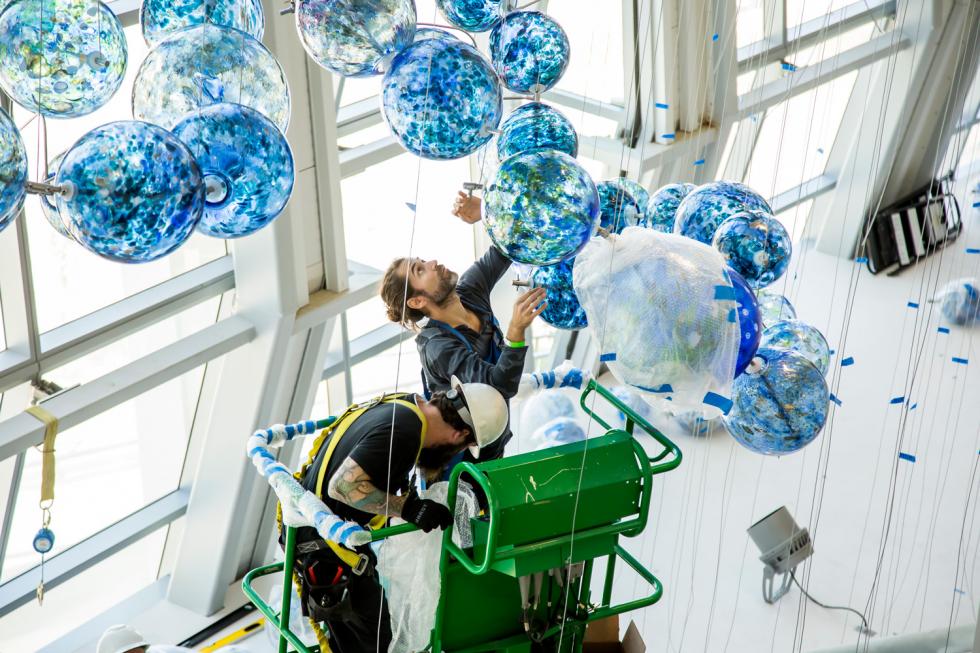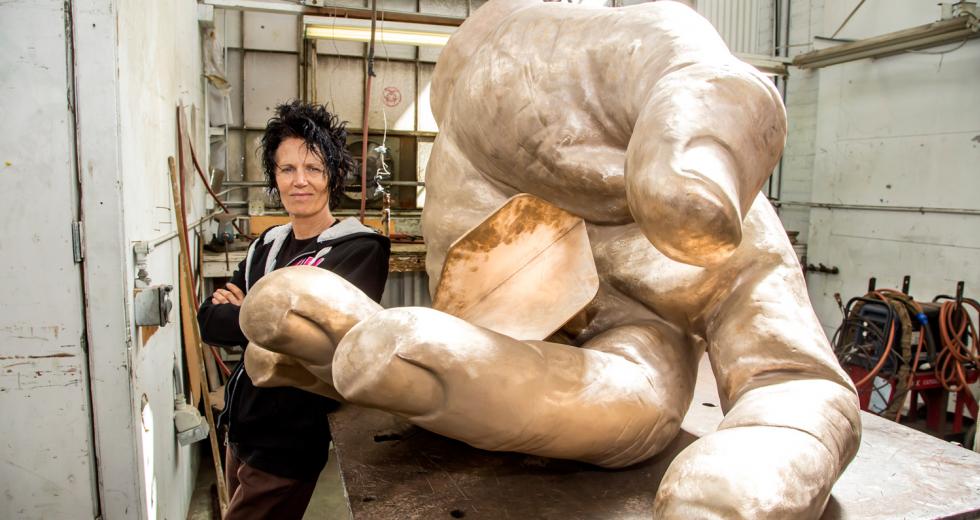By most accounts, the ArtStreet installation — a collection of works by over 100 Sacramento-area artists — was a success. Some 32,000 visitors passed through the old warehouse off Broadway that played home to the art project for its three-week run last February. ArtSteet was the largest free art exhibit in the region’s history.
But just before the showcase opened, local artist Heston Hurley took to social media to vent his frustration that organizers rejected his piece: a red, white and blue park bench in the shape of a swastika he’d created last minute as a statement against the Dakota Access Pipeline.
Word of the work’s removal spread, and ArtStreet’s launch was in danger of being overshadowed by controversy. M5 Arts, the group who put on the event, moved fast to make their case that Hurley’s piece was different than the concept he’d originally submitted. Hurley, for his part, told his followers to continue to support the show.
But the brief tiff rattled the region’s tight-knit artist community. And it provided a glimpse of the difficult terrain — best navigated with skills both hard and soft — one must traverse in order to succeed as a full-time creator in the business of art.
Believe it or not, it’s possible to make a living as an artist in Sacramento. All it takes, according to those who’ve succeeded, is a base of communication, community, willingness to treat your work as a business and a good share of bull-headed persistence. Visual artists spend a great deal of time alone, in their studios and in their heads. But the ones who practice their craft for a living say that interacting with the outside world is vital to success.
One thing Sacramento artist Bryan Valenzuela wishes he’d known in his early years is just how much work goes into the job outside of the studio. Attending events. Shaking hands. Traveling across the country to art shows. “No one’s gonna all of a sudden discover you,” Valenzuela says. “You have to put yourself in those positions, in as many opportunities as possible.”
Hustle Never Stops
Valenzuela’s most recognizable work may be his public installation “Multitudes Converge,” suspended over an entrance inside the Golden 1 Center. He was commissioned $350,000 by the Sacramento Metropolitan Arts Commission for this piece. But he’s long been known in the region for intricate, surrealist drawings of human-like subjects that mix rich reds, blues and golds with stoic grays. He even created a series of these images to be wrapped around utility boxes on downtown Sacramento street corners.
Valenzuela has built a career crafting detailed drawings that, upon closer look, are a collection of strings of impossibly small handwritten text. His work tends to explore how a large body is in fact an intricate collection of its smallest elements. Similar to Valenzuela’s drawings, his attention to the little, daily tasks of putting himself out there — as essentially an entrepreneur — has made it work for this artist in the big picture.
Sacramento painter Kathrine Lemke Waste agrees. “If you can’t get out and tell people about yourself and what makes you unique and different, you’re not going to do as well as the artist that can do that,” she says.
Lemke Waste moved to the art world from academia mid-career and has built her community by joining American Women Artists, a national network for female artists of which she now serves as president. Her contemporary realist paintings — studies on light, pop culture and classic still-life imagery — appear in galleries and exhibitions throughout the western United States.
Bryan Valenzuela installs his sculpture “Multitudes Converge” at
the Golden 1 Center in September 20

An artist needs to be a part of the community, but that’s not to say they can’t ask tough questions or challenge norms. This is, after all, one of the main points of art. Valenzuela’s ArtStreet piece, “Autumn of the Insider,” laments the downside of a city on the rise with a quote asking: “Will they silence the artists, the poets and the poor, throw them to the ditch, on the road to building their playground for the rich?”
Gale Hart’s publicly-funded sculpture “Missing the Mark,” located outside the Golden 1 Center, is a winking critique of the western world’s obsession with point-oriented competition, like basketball. Dubbed “Sacramento’s Godmother of Contemporary Art” in the Sacramento Bee, the 61-year-old skateboarder ran almost a dozen ideas by the former head of SMAC before landing on the installation that now stands on the southern end of the arena — a smattering of 12-foot-darts, giant bronze hands and a dart board with wandering numbers that seem to melt and bend like the clocks in Dali’s “The Persistence of Memory.” Hart, a sculptor and painter, was commissioned $300,000 for this piece.
There is power in art and, according to Hart, sometimes the act of creating can elevate the artist in his or her own mind. “I think creative people are all kinds of narcissistic,” she says. “It’s part of being creative, it’s not something you can get rid of and it’s good to have.”
But this personality trait can complicate things when disagreements come up with potential patrons or business partners. “Sometimes in those conflicts, it’s because that gets out of check,” Hart says. The outspoken artist has had her share of disagreements over the years, but she can’t recall anything amounting to a burned bridge. It does help to keep work and personal relationships separate, she adds.
In such times of conflict, having a community of artists helping to navigate your way to resolution also proves useful. The day after Hurley’s pained post caught regional media’s attention, he took to Facebook with a more conciliatory tone.
Listen now - Action Items: Expanding Our Creative Capital
“I fully support ArtStreet, and M5 Arts,” he wrote. “What happened to me was the result of individual/individuals that in no way represent the amazing job done by ArtStreet or M5 Arts. Go support your local artist.” (Hurley did not respond to Comstock’s request for comment.)
Hart was among the first to comment. “Understandably emotions sometimes rule but you are taking the high road,” she wrote. “Good on all of you for working it out and being supportive.”
Looking back, Valenzuela chalks the ArtStreet dust-up up to miscommunication. Neither he nor Hart are eager to talk about this uncomfortable ripple in the Sacramento art scene’s otherwise strong history of collaboration and support, but they do stress the sense of community shared by local creators.
“I think probably one of the most important things about being in any creative field is being able to create a network of like-minded people, of friends,” Valenzuela says, “and [to] learn from other artists in what they’re doing, whether it be business-like or in the actual creative pursuit.”
Treat Art Like A Business
Here’s something else artists don’t learn early on that can get them into trouble: bookkeeping. “There isn’t a lot of business taught in art school,” says Alan Bamberger, author and creator of ArtBusiness.com, a website dedicated to helping artists navigate the business side of their craft. “You have to do everything. Nobody’s gonna do it for you from the start.”
Paperwork takes time out of the studio, so artists don’t like to do it. Yet maintaining one’s craft as a business is important to success. Valenzuela carves out Monday mornings to straighten out his books, check inventory and respond to emails. “I just developed that mindset that I have to do it if I want to keep this train rolling,” Valenzuela says. “The earlier people do that, the better. But it took me a long time, unfortunately.”
Ever since Hart started her career living in a van four decades ago, it was the business of art that kept her out of the 9-to-5 workweek. “I was driven, more than making my art, to make sure I could survive off of it,” Hart says. “I think that helped make it a business.” In the outset, she says, a young artist doesn’t have the luxury of delegating work. “You’re everything. You have to wear all those hats.”
It is a lot of work. More than most young artists might expect. But the ones who can stick with it are the ones most likely to succeed. “It’s tenacity,” says Lennee Eller, interim executive director of SMAC. “It’s when you have a passion and you’re tenacious about learning your skill very, very well and then knowing what’s important to you.”
Making it in the world of art also involves knowing where to look for patrons and sources of funding. Hart’s installation at the Golden 1 Center was her first foray into public art — and local creatives are seeing more public funding going up for grabs. In June, Mayor Darrell Steinberg committed $250,000 per year over two years to SMAC, and announced the Creative Economy Pilot Project, which has one-time funding of $500,000 available in small grants for arts and cultural events.
The same rules apply for success in the public art world as when working with private collectors: strong communication, community building, a business-minded approach. And staying positive. Hart says negativity is the killer for some artists. That’s not going to fly in such a demanding field. “I don’t know a job that’s harder,’ Hart says. “It’s crazy hours that I keep and it’s really demanding physically.”
Artists pursue their line of work out of love and passion — and, like all tough careers, the successful ones battle through the tough times.
Valenzuela recently had the chance to talk with celebrated San Francisco sculptor Al Farrow, whose work creating religious buildings using guns and ammunition was showcased at the Crocker Art Museum at the end of 2016. Now in his 70’s, Farrow told him he didn’t really start getting recognized until about 10 years ago.
“He basically said you already shot yourself in the foot if you give up,” Valenzuela says. “You’ve already taken yourself out of the game.”




Comments
It's exciting to see the support visual artists are finally receiving in Sacramento. Wish it extended to the writing community.
Happy to see artists being recognized as the creators of culture that they are, but we need to address the housing crisis if we want to ensure that artists can live in our communities! Bryan's ArtStreet piece says it all.